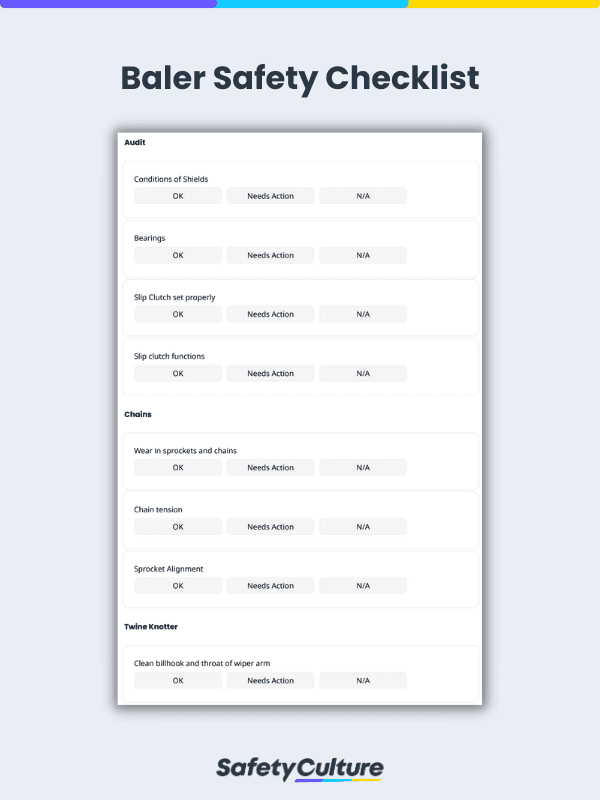What is a Baler Safety Checklist?
A baler safety checklist is a tool used by operators to ensure business compliance with safety protocols to prevent workplace hazards. It helps assess the readiness and condition of the baler machine to protect employees from unnecessary incidents including the likelihood of severe injuries, amputation, and worse fatalities.
Importance of Baler Safety in the Workplace
Baler machines are used with high compression force to compact scrap and refuse material into bundles for efficient handling. Baler safety in the workplace helps protect operators from workplace hazards; boost employee productivity and efficiency; implement proper usage of baler machines; and maintain baler in good working conditions.
How to Effectively Implement Baler Safety
Baling machines are used across industries including agriculture, industrial, and manufacturing. It helps reduce a large amount of scrap into compact waste for easy handling, disposal, and transport. Implementing baler safety in the workplace is paramount to prevent unnecessary incidents and maintain a safe working environment for operators. The following tips will help effectively implement baller safety.
Baler Safety Training
It is important to know the basic baler standard operating procedure before using the equipment. Baler machines may operate in a manual, semi-automatic, or automatic mode. Operators should undergo training in safe work methods including information on policies, procedures, manufacturing details, and safety precautions before assigning them to operate the equipment. Operators should understand the different risks such as electrical, physical, and ergonomic hazards prior to operating the machine.
Baler Safety Operating Tips
Employers should restrict unauthorized employees from touching the baler machine. Only trained operators should use, clean, and maintain balers. Wearing appropriate Personal Protective Equipment (PPE) including safety glasses, gloves, and steel-toed shoes may be required during the operation. Here are some safety tips when using a baler:
- Post appropriate safety warning signs.
- Inspect the baler prior to each use to ensure safe operation. Check if there is a lock or tag placed on the baler.
- Don’t operate the baler machine if there are defects found during the baler safety inspection.
- Check if there are inappropriate objects including glass, liquid wastes, and metal before compaction.
- Don’t stand at the front of the baler when compaction starts.
- Shut down the baler machine when clearing jams.
- Always put the sharp (cut) end of the baling wire in a face-down position to avoid injuries.
- Always keep wires, cutters, and other tools away from the baler when unloading.
- Ask for assistance when moving the stack to avoid musculoskeletal injuries
- Remove the key from the switch after use to prevent unauthorized operations.
- Clean the baler and the floor area after use.
Baler Inspection
It’s important to inspect the baler machine regularly to check for defects or damages. It’s recommended to inspect the Baler everyday, before and after each use. It helps ensure worksite safety and continuous operation. Neglecting this can incur costs since underlying issues won’t be resolved and it prevents the baler from running at its peak performance.
Baler Maintenance
A regular check helps maintain equipment reliability and improve its efficiency. Early defect or damage detection can save both time and money if repaired immediately. Having consistent documentation of repairs and diagnostics can help identify broader trends and support future investigations.



